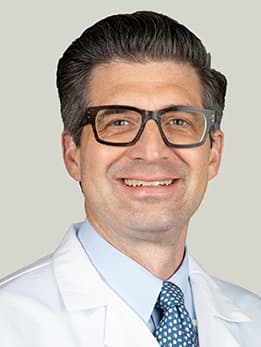South Side resident takes part in rare sickle cell disease clinical trial through UChicago Medicine

Lyric Porter has been a patient at the University of Chicago Medical Center since the day she was born. As a newborn, Porter was diagnosed with sickle cell disease (SCD), a life-threatening blood disorder affecting a person’s red blood cells, including their shape, function and ability to carry oxygen throughout the body.
For many years, this diagnosis often meant a lifetime of medical complications and struggles to find curative treatment. However, new therapies are emerging that could offer hope to SCD patients. Porter participated in a stem cell gene therapy clinical trial at UChicago Medicine that provided important evidence in favor of this promising new treatment approach.
Life with sickle cell disease
Because of genetics, people with SCD have abnormal hemoglobin, which is the protein in red blood cells responsible for carrying oxygen. This abnormality causes red blood cells to contort into a “sickled” crescent shape. These sickled cells have a much shorter life span than healthy, round red blood cells and are ineffective in supplying the body with oxygen. Because of their shape, sickled cells can get stuck in blood vessels, creating blood flow restriction that can cause intense pain that SCD patients call a “sickle cell crisis.”
SCD can result in sickle cell anemia: a condition where the body does not have enough healthy red blood cells — and thus, oxygen — throughout the body. Anemia can cause fatigue, weakness and dizziness.

James LaBelle, MD, PhD
James Labelle, MD, PhD, provides care for children of all ages with cancer and blood diseases, including leukemia and lymphoma. In particular, Dr. LaBelle specializes in stem cell transplantation, replacing a patient's diseased bone marrow and immune system with healthy cells.
Learn more about Dr. LaBelle
Pediatric Hematology, Oncology and Stem Cell Transplant
Our world-class hematology, oncology and stem cell transplant experts offer collaborative and compassionate care for every child. We diagnose and treat pediatric blood disorders and cancers using advanced treatment methods and innovative research.
Learn about our kid-focused care
Porter, now age 27, spent her childhood enduring the physical and emotional challenges that resulted from the disease. She suffered from breathing issues, as well as jaundice, a condition that can cause yellowing of the eyes or skin due to the build-up of yellow-tinted bilirubin in the blood. (In people with SCD, the liver can’t filter out quickly dying sickled cells fast enough and converts the excess hemoglobin from dying red blood cells to bilirubin.)
“I had an oxygen tank in kindergarten that made it apparent that I was different from the other kids,” Porter said. “The biggest issue was the jaundice in my eyes — they would turn yellow. It was something people noticed immediately, and I definitely got teased for it. That affected my self-esteem.” She said it was difficult to regain confidence as a child because the symptoms were beyond her control, unlike some other insecurities that often affect children’s self-esteem.
By the time Porter was in her early teens, she was experiencing a sickle cell crisis twice monthly, sending her to the ER or leaving her in the hospital, unable to carry on with daily life. She also underwent monthly blood transfusions to provide her body with some healthy red blood cells from a donor in hopes of limiting pain and sickle cell crises.
Choosing to be at the forefront of treatment
In 2019, after graduating from college, Porter learned of a clinical trial from her physicians at UChicago Medicine. She was open to trying something new because she wanted an alternative to blood transfusions and bone marrow transplants. Hoping to experience a better quality of life with fewer limitations, she ultimately decided to take a leap of faith, enroll in the trial and begin the experimental treatment.
“I was nervous about the trial, because I would be the first patient in Illinois to get it done and only the third patient in the world,” said Porter. “The biggest thing that encouraged me to participate was that I knew many people who had passed away from the disease by the age of 25. I was approaching that age, and I liked the idea of potentially having a better life.”
It is still early, but it is clear that gene correction of stem cells from patients with sickle cell disease will become a bona-fide treatment option for some patients.
The trial used gene therapy to modify patients’ stem cells — the early-stage cells found in bone marrow that are used to create new blood cells in the body. With the modification, the stem cells would help produce healthy red blood cells to replace sickled cells.
“One thing that makes gene therapy unique from traditional stem cell donor transplants for this disease is that the process uses the patient’s own stem cells, which also bring the patient’s normal immune system” said James LaBelle, MD, PhD, the director of the Pediatric Stem Cell and Cellular Therapy program at UChicago Medicine and Comer Children’s Hospital and the primary investigator on the clinical trial. “This bypasses many of the complications of transplanting someone else’s stem cells and their immune system, which necessitates patients be on immunosuppressive medications to prevent the new immune system from attacking the patient.”
The clinical trial was the first to target a new region in the DNA code that regulates the synthesis of sickle cell hemoglobin. The modification process targets areas of DNA that bind a protein called BCL11A, which controls the amount of adult hemoglobin and fetal hemoglobin that the body produces. The body usually stops producing fetal hemoglobin during infancy to make way for the production of adult hemoglobin. In patients with SCD, this adult hemoglobin is sickled. The goal of this gene therapy was to inhibit the ability of the BCL11A protein to facilitate this switch so the body produces fetal hemoglobin instead of sickle hemoglobin in blood cells.
Persevering through a multi-step treatment process
Once enrolled in the clinical trial, Porter spent months in intensive medical preparations for the gene therapy. She underwent preliminary testing, bloodwork, exams and scans to confirm that her body was well enough to withstand the necessary procedures. She received monthly red blood cell exchanges, in which a machine removed some of her sickled red blood cells and replaced them with healthy red blood cells from donated blood. While not very painful, the process is very draining, according to Porter. To ensure that she would have the option of having children even after receiving chemotherapy, she also underwent IVF procedures to harvest eggs to be frozen for the future.
In 2022, Porter’s stem cells were taken, or “harvested” from her body three times to provide a sufficient amount of stem cells to modify for the transplant. Each harvest happened over the course of three to four days. After Porter underwent the harvest process, the cells were frozen and sent to facilities in Germany — home to the biotechnology company providing services on the trial. At that point, they were thawed and genetically modified before being returned to Chicago.
To prepare for her stem cell reinfusion procedure, Porter underwent chemotherapy over four days to improve the likelihood that her body would accept the stem cells. She experienced side effects such as hair loss, infection risk and hyper-pigmented skin and nails, but in August of 2022 she was able to begin infusions to receive her millions of modified stem cells — one infusion a day for two days for roughly two hours at a time.
A brighter future for sickle cell patients
Porter’s body did accept the modified stem cells, so she now has a greater amount of healthy hemoglobin circulating in her veins. Along with the other patients in the clinical trial, she saw a decrease in the number of sickle cell crises she experienced — a positive sign for her quality of life going forward.
“We are encouraged by the results of this novel gene therapy trial,” said LaBelle. “It is still early, but it is clear that gene correction of stem cells from patients with sickle cell disease will become a bona-fide treatment option for some patients. These are very exciting times.” Two gene therapies for SCD have now been submitted for FDA approval.
While Porter remains hopeful as she continues her recovery, she recognizes the need for further advancements for treating SCD. “There’s a big disparity for people who suffer from sickle cell disease because they don't have many options,” she said. “I have definitely been through a lot in advocating for myself with sickle cell disease.”
Porter advocates for others as well as herself. She even partnered with WebMD to create a virtual support group for SCD patients and their families, with the goal of fostering connections and encouraging frank discussions about treatments, patient care, awareness and advocacy. ”I do it because I hope that the patients who come after me will not have it as difficult as I've had it over the years while living with the disease,” she said.
